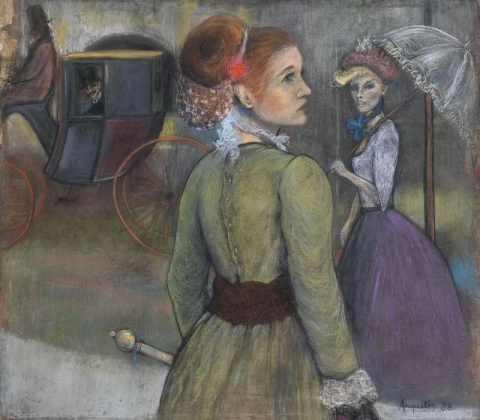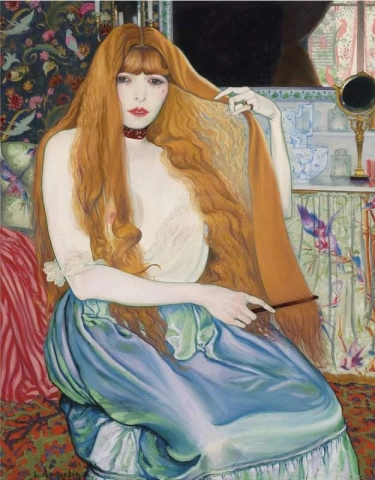

Hand painted reproductions of Louis Anquetin
Louis Anquetin: A Visionary French Painter of Post-Impressionism
Early Life and Education
Louis Anquetin (1861–1932) was a notable French painter, best known for his contributions to Post-Impressionism and his pioneering role in the development of the Cloisonnism style. Born in the town of Asnières-sur-Seine, near Paris, Anquetin demonstrated an early interest in art. He pursued his education at the École des Beaux-Arts in Paris, where he honed his technical skills and began exploring the dynamic world of contemporary art.
Anquetin was part of a group of young artists in Paris who sought to break away from traditional artistic conventions. He was greatly influenced by the work of the Impressionists, as well as by the emerging trends in color theory and brushwork. It was during his studies that Anquetin encountered fellow artist Henri Toulouse-Lautrec, who would have a significant impact on his career.
Artistic Development and Style
Louis Anquetin’s artistic journey was marked by his early embrace of the Post-Impressionist movement and his eventual collaboration with artists such as Paul Gauguin and Henri Toulouse-Lautrec. Anquetin initially worked in the style of Impressionism but later moved towards a more distinctive approach that would become known as Cloisonnism, a style that emphasized bold outlines and flat, vibrant colors.
Anquetin’s works were often characterized by his use of strong, outlined forms, which were influenced by the medieval stained glass windows that inspired the Cloisonnism technique. His distinctive style involved the use of black lines to delineate the various sections of color, creating a flat, almost two-dimensional effect. This approach was a significant departure from the spontaneous and fluid brushwork of the Impressionists.
Throughout his career, Anquetin explored a wide range of subjects, from portraits to urban scenes, often depicting the vibrant life of Paris. His palette was rich and saturated, with a focus on the interplay between color and light. His approach to color was highly structured, as he aimed to achieve harmony and balance through careful placement and contrast.
Themes and Significance
Anquetin's work was deeply influenced by the bustling urban environment of Paris, and many of his paintings feature scenes of daily life in the city, including street scenes, cafés, and the theatrical world. He was particularly drawn to the vibrant social life of Paris, capturing the energy and movement of the city’s streets and its inhabitants.
One of the key themes in Anquetin’s work was the depiction of modern life, as he sought to convey the dynamism and excitement of the rapidly changing city. His subjects were often ordinary people—workers, performers, and café-goers—capturing them in candid moments that conveyed a sense of vitality and realism.
Anquetin’s significance lies in his ability to blend the color experimentation of the Post-Impressionist movement with the structure and formality of earlier artistic traditions. His distinctive use of color, composition, and line made him a key figure in the evolution of Post-Impressionism, and his work continues to inspire contemporary artists today.
Achievements and Influence
Louis Anquetin’s contributions to the French art scene were significant, particularly his role in the development of Cloisonnism. His collaboration with Henri Toulouse-Lautrec and other artists at the time helped to solidify his reputation as an innovative and influential painter. Anquetin exhibited his works in several prestigious exhibitions, including the Salon des Indépendants, where he gained recognition for his unique style.
Though he did not achieve the same level of fame as some of his contemporaries, Anquetin’s work had a lasting influence on the development of modern art. His experimentation with color and form was admired by fellow artists and collectors, and his work can be seen as a bridge between the Impressionist movement and the more structured approaches of artists like Gauguin and van Gogh.
Anquetin’s impact extended beyond his own paintings, as his ideas about color and composition were adopted by other artists, particularly those who sought to move away from the naturalism of earlier periods. His exploration of line and color made him an important figure in the evolution of modernist art.
Legacy
Louis Anquetin’s legacy as a painter lies in his innovative contributions to Post-Impressionism and his development of the Cloisonnism style. His works remain important for their exploration of color, line, and form, and they continue to be admired by collectors and art enthusiasts around the world.
Today, Anquetin’s paintings can be found in prestigious museums and private collections, where they are celebrated for their technical skill and unique perspective on modern life. His legacy as a pioneering figure in French art continues to be recognized, with his work inspiring generations of artists who have sought to push the boundaries of color and form.
Where to Find Reproductions of Louis Anquetin’s Art
For those wishing to bring the vibrant, dynamic work of Louis Anquetin into their homes, POD (Painting On Demand) offers high-quality oil painting reproductions of his masterpieces. These reproductions allow collectors to experience the bold lines, rich colors, and modern flair of Anquetin’s Post-Impressionist style in the comfort of their own spaces.
Imagine owning an original-style painting by one of the greatest artists in history. At POD, we offer you the chance to make this dream a reality. Each canvas is faithfully reproduced down to the smallest detail, allowing you to experience the beauty of the artist’s vision in your own home.
Our reproductions are crafted by experienced painters using the finest materials and time-honored methods. We are committed to delivering works of exceptional quality that will inspire and bring joy to your family for generations to come.























